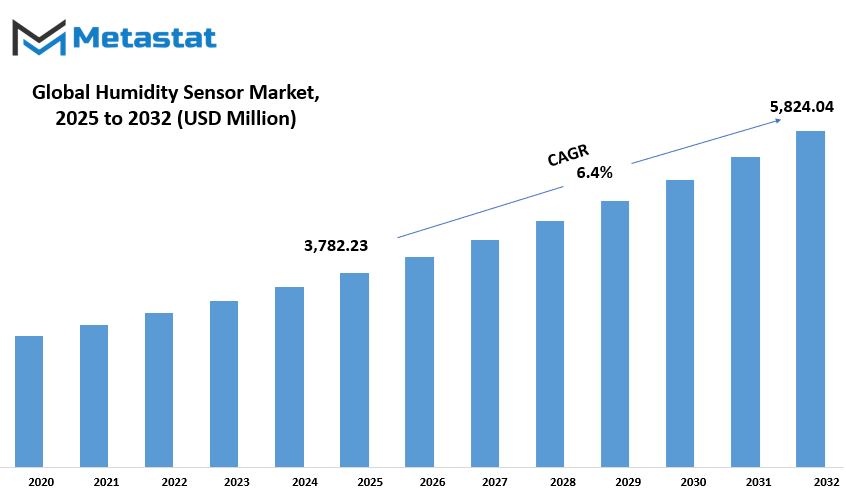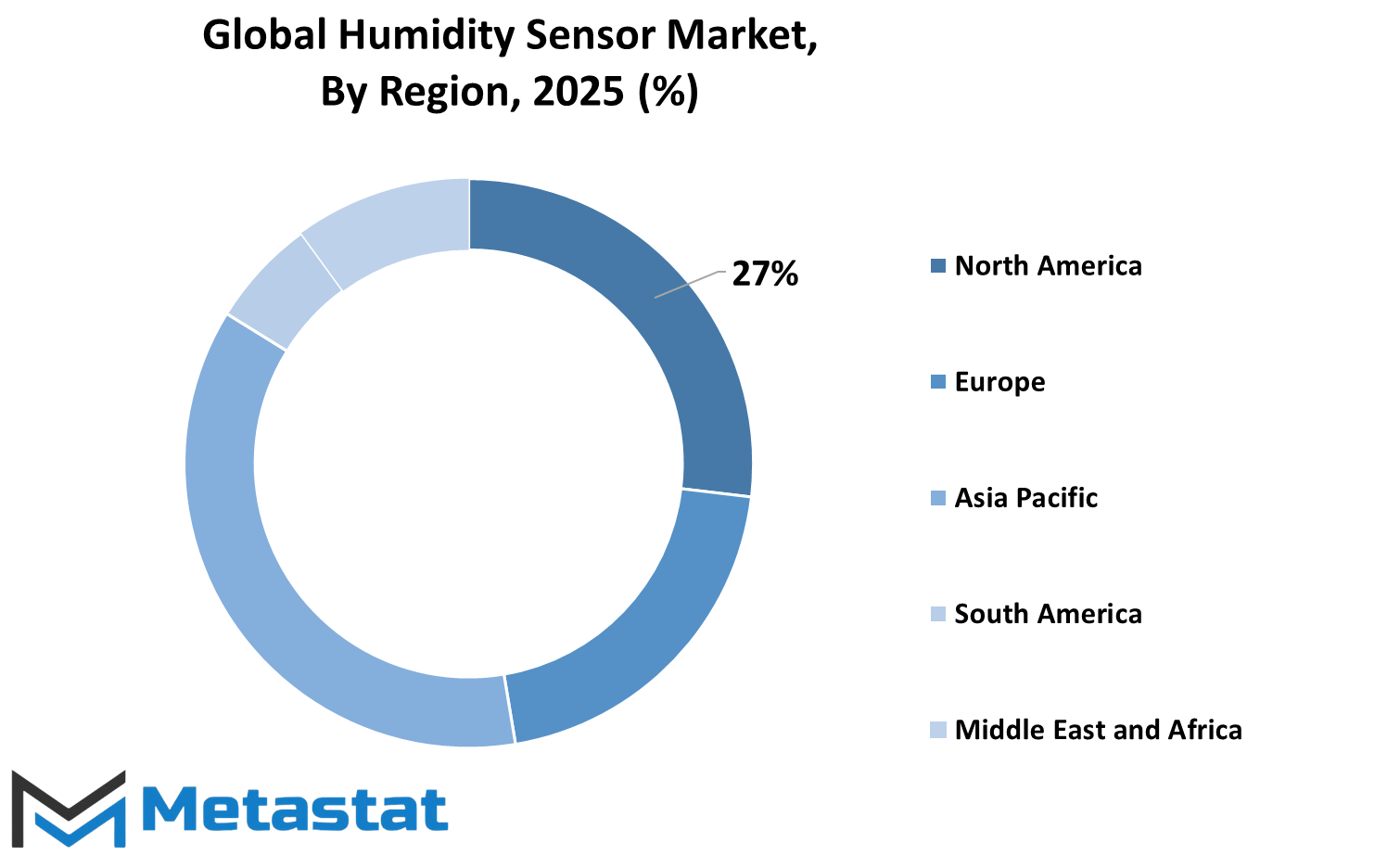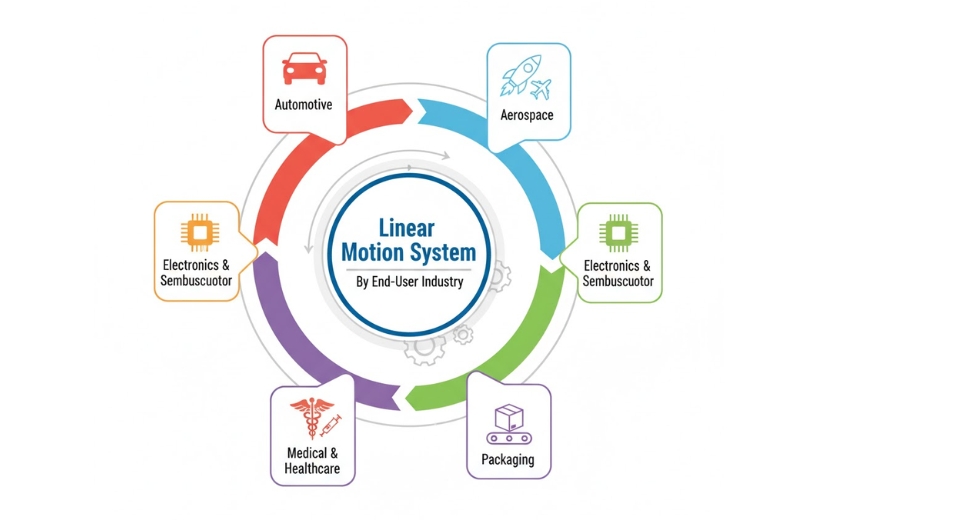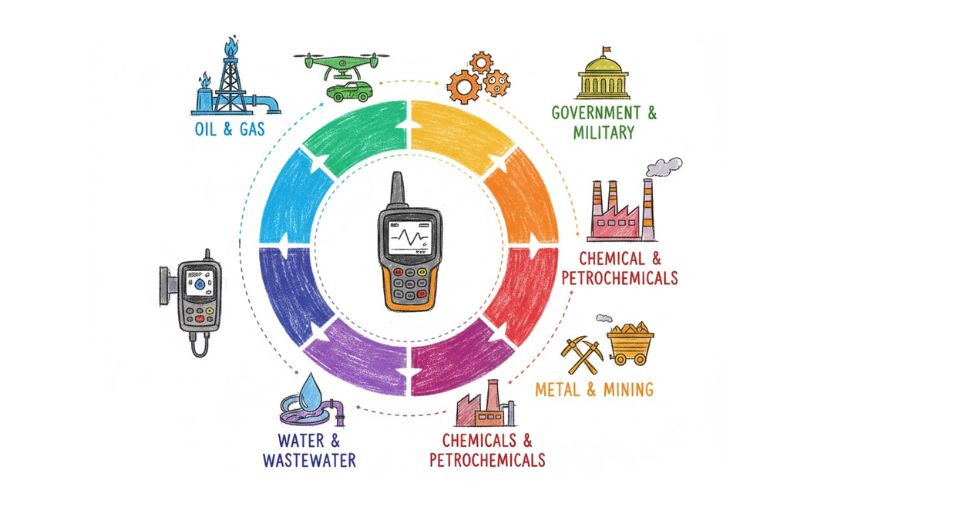MARKET OVERVIEW
The global humidity sensor market paints a picture of a progressing industry which is moving by strides propelled by technology and the increased demand for accurate environmental monitoring. As industries are expected to grow, so is the spectrum of applications in which humidity sensing technologies may find relevance, hence their market development. Industries today witness transformation as they continue to adopt such technologies across applications that penetrate a wide spectrum-from automotive to healthcare and industrial automation to consumer electronics. Humidity sensors measure and control moisture levels within various environments and are now part and parcel of optimizing processes in becoming more operationally efficient.
Reliable and accurate humidity measurement solutions have now become the demand by industries, and hence a lot more open-eyedness towards innovation and product refining. Sensor technology companies are now continuously involved in enhancing the durability, sensitivity, and miniaturization of these devices to meet the necessary requirements-rest of the end-users. Implementation of advanced materials and sensing mechanisms will enhance performance and allow these sensors to work perfectly in varied climatic conditions. Life of products in pharmaceuticals-to improve automobile climate control systems-industrial processes require stringent moisture control, and so on, are some of the applications those devices serve in the current technological setup.
The intensive usage of these sensors in various industries correspondingly raised intensive research activities on improving their efficiency and extending their capabilities. Continuous developments in digital sensing technologies coupled with the increasing trend of wireless communication have significantly influenced the path of the global humidity sensor market. The smaller forms are now included in portable devices and smart home systems which allow users to monitor humidity with better accuracy. That is why the industries are shifting to automated and interconnected systems; the momentum gained about the need for intelligent sensing solutions never stops.
Besides, the global humidity sensor market is also preparing with innovations in calibration and response time for better real-time data collection. The integration capabilities of these sensors into highly complex networks add to their growing importance to sectors that require accurate humidity management. Some improvements in environmental monitoring have also occurred in medicine, such that the environment within medical storage facilities, for example, is regulated to optimal conditions, thus benefiting pharmaceuticals as well as very sensitive medical equipment. Another similar industry is agriculture; it determines the exact humidity as it's merely a common essential for cultivated environments and improves yield management and resource optimization.
Humidity sensing technologies, at the heart of new developments, will nevertheless work on industry-specific challenges. Sensor life, contamination, effectiveness, are some of the core areas in consideration for development. Manufacturing cycle improvement and price reduction on the performance front have resulted in enhanced sensor availability across the markets.
The growth of humidity sensing technologies appears directed by the escalating adoption of smart solutions interfaced to artificial intelligence and machine learning algorithms. Such means allow for predictive functions of sensors and hence reinforcement toward automation and process optimization. Due to the enhancement of IoT applications, humidity sensors are further expected to undergo changes to help industries achieve operational precision and efficiency.
Global humidity sensor market is estimated to reach $5,824.04 Million by 2032; growing at a CAGR of 6.4% from 2025 to 2032.

GROWTH FACTORS
IoT or the Internet of Things is propelling higher growth of the global humidity sensor market across different industries. Humidity sensors have been made indispensable for applications that involve precise detection of environmental conditions with devices that have undergone rapid technology advancement. Healthcare, agriculture, and manufacturing are some of the industries that use these sensors to create optimal ambient conditions for maximizing operational efficiency and maintaining quality. Thus, the ability to acquire humidity data in real-time is now considered a must-have for automation of the present age for enhanced decision-making and operational efficiency due to IoT advancement.
With greater demand for HVAC (Heating, Ventilation, and Air Conditioning) systems, the global humidity sensor market is scaling up. Humble humidity sensors worldwide assure energy performance and comfort in residential, commercial, and industrial horizontal income generators to create and maintain desired indoor environments. These sensors make sure maximum air quality with minimum energy losses and maximum system performance. As climate change escalates, and temperatures continue to rise, the demand for cutting-edge HVAC domains and humidity sensors rises.
While there are some bright sides for the global humidity sensor market, challenges also affect it. One of the greatest challenges facing this industry is the acceptance of advanced sensors at high costs. Therefore, approved installations are limited in cost-sensitive industries. Basic humidity sensors are usually cheap and easily available, whereas advanced hygrometers with high precision introduce a considerable investment.
Thus, their extensive usage in small and medium enterprises needing highly priced technology is limited. Calibration and accuracy problems arise as another hurdle. Consistent performance over time requires the apparatus to be calibrated, which can be time- and cost-intensive. Aside from that, the environmental factor or sensor drift could cause their humidity readings to vary, and that poses a major roadblock for data reliability, thus compelling manufacturers to work nonstop to advance sensor technologies.
New opportunities for humidity sensors are likely to come forth from the increase in wearable devices. The surge of smart health monitoring devices indicates that humidity sensors will likely be incorporated into wearables that monitor environmental conditions affecting human health. These sensors will be useful in fitness tracking, respiratory monitoring, skin hydration analysis, etc. The advanced sensing capability features in wearable health monitors are expected to spur a rise in consumer interest, hence throwing new light on the new path before the expansion of the market.
In conclusion, the global humidity sensor market has a brighter growth prospect, supported by technological advancement and increasing application areas. Certainly, challenges exist; however, a constant innovation path with the smart solution demand will carry this market along the road and foster its relevance in various industries.
MARKET SEGMENTATION
By Type
The global humidity sensor market Significant Sector in Important Activities wherein it is critical in all the applications which require important control with respect to moisture and its control. Also, the sensor can help maintain optimal standard conditions in the various sectors of healthcare, automotive, food processing, agriculture, and industrial manufacturing. In addition, the demand for humidity sensors has been increasing because of the fact that they can also product quality, improve operational efficiency, and ensure safety measures. Due to the fact that the global humidity sensor market has been observing a continuous increase due to increased awareness toward environmental monitoring in addition to the growing need of accurate and modern climate control solutions, it has turned out to be
Types of sensors, one of the major classifying under these market tests of Absolute Humidity, valued at $606.35 million, are very much applied for highly exact measurements on the moisture content in the air and are used often in the industry as they take accuracy in measurements as a prime component in value. The most important part is Relative Humidity Sensors, as this is essential for most HVAC as well as the basic component of consumer electronics, which will provide the right ambient environment within the house to hold in comfort.
Optical Hygrometers use more of the latest optics to measure humidity levels and are hence best suited for scientific as well for specialized industrial requirements. Oscillating Hygrometers work by altering the conditions of their resonance due to moisture absorption and can be used in a variety of meteorological and laboratory setups under the conditions being measured. In addition to that, other types of sensors are making inroads as technology is innovating into the measurement of humidity.
Humidity sensing has come into the limelight in terms of wide application owing to the growing demand for automated climate control and environmental monitoring. Humidity sensors have found very broad applications in medicine, especially in the storage areas of pharmaceutical products and medical devices, where humidity is required to be maintained at a steady low level. It is also apparent that in an automobile, humidity sensors are essential for air conditioning controls and windshield anti-fogging, furthering passenger comfort for the competent functioning of the vehicle.
Controlling humidity within certain precise threshold limits is essential in the actual food processing and storage, as it helps keep the products fresh along with preventing spoilage. Agriculture is another sector where such sensors are immensely needed in applications such as greenhouse management, irrigation control, and crop health monitoring. The presence of these sensors will directly intervene with yield and quality.
It is these technological innovations that are expected to lay the foundation for the future of the global humidity sensor market. Developments in this specific sector at this point are mainly committees on miniaturization, enhanced accuracy, and wireless communication. The emphasis of these smart sensors is on IoT-enabled smart sensors, which deliver remote monitoring, experience automation, etc. Ideally, with such advancements, efficiencies are gained in various sectors with the real-time collection and analysis of data in empowering better decisions. The slow revolution toward sustainability has been addressed concerning energy-efficient and eco-friendly sensor solutions as this also embodies the concept of reducing carbon footprints at a global level.
Demand for humidity sensors is likely to be continuous due to ongoing progress within industries that favor automation and data-based decision-making. Versatile sensors capable of fulfilling multiple applications are becoming imperative in modern technological designs. These changes bring into successful implementation even more advanced capabilities and continue to enhance the sensor technologies so that they can be increasingly used in all sectors for optimal control of environmental condition parameters.
By Material Type
The sensors marketed widely become rampantly facile with burgeoning global humidity sensor importance. Precisely, for industries straddling the automotive, healthcare, industrial automation, and consumer electronics sectors, they are high in demand for measuring humidity applications. The involvement continues to enlarge demand across all industries in line with greater environmental monitoring and climate control.
It is the performance, durability, and sensitivity of humidity sensors, strongly determined by material used for constructing humidity sensors. These materials are semiconducting metal oxides widely used because they operate under different environmental conditions, remain stable, and deliver reliable readings. They can also respond to variations in humidity, making them ideally suited for development and evaluation in industrial and environmental applications.
Another technological category important in sensing is ceramic sensing owing to its durability and preference for applications in industries that require sensors that withstand harsh high and low temperature and humidity. Polymer-based humidity sensors are flexible, cost-effective, and mostly used in household electronics, HVAC systems, and healthcare devices due to their lightweight construction and easy integration. Other than these broad categories in development are other materials that are being explored for their capacity to improve performance, longevity, and accuracy for particular applications.
The increase in humidity sensors has introduced smart homes and industries in further innovations towards its smart applications. In modern smart device appliances, these sensors work to keep indoor air quality by modulating humidity. Hence, precise setting controls boost comfort and energy efficiency especially in HVAC systems. In auto, humidity sensors are intended for controlling climate settings and for safety features to visibility and comfort of passengers in extreme weather conditions. At home, these sensors support medical equipment that requires precision in environmental parameters for accuracy and reliability of sensitive devices.
With the advancement of technology every day, humidity sensor manufacturers are narrowing down into a more miniature version of highly sensitive and energy-efficient ones with increased accuracy. They are also connected to wireless networks and integrated with the IoT to provide real-time monitoring and adjustment functions. This is intended for an environmentally conscious population in which industries are looking at the utilization of eco-friendly materials and energy-efficient production processes to minimize their overall environmental impact. The global humidity sensor market is anticipated to be dynamic with ongoing ongoing advancements in increasing application of the market across industries.
By End User
The global humidity sensor market is, in a way, the lifeline to much of its activity. It meets needs of residential, commercial, and industrial end-users. Due to technological advancements, there is now a greater need for precise humidity measurement in numerous applications-from domestic, where sensors ensure a pleasant indoor environment by the regulation of air quality and the prevention of excess moisture leading to mold and various health issues, to the integration of humidity sensors into home automation systems for improved climate and energy control.
In the realm of commercial applications such as offices, malls, or healthcare buildings, controlling humidity levels is pivotal to good indoor air quality, thus sustaining sensitive equipment for a long time. For example, the hospital is one place where relative humidities must be tightly controlled to limit bacterium growth and maintain medical supplies sterility. Equal monitoring is achieved in data centers in preventing failures by detecting moisture-related attacks on electronic components. After all, smart building technologies make a strong case for humidity sensors in contemporary infrastructure.
A broader drive exists in the industrial application area for humidity or environmental sensors, especially within manufacturing, food, and pharmaceutical processing. In manufacturing, humidity can affect products, material properties, and machine function. The food and beverage industry finds humidity monitoring critical to storage for preservation. Pharmaceutical production functions of environmental controls, wherein sensors maintain legal standards for the protection of medicines and vaccines. Humidity sensors present a great advantage to the automotive industry in almost all climate control systems and electronic components, where moisture affects the performance and safety of those systems.
Sensor technology advances have given birth to devices that are more accurate and compact and consume less power. Wireless and IoT-enabled humidity sensors are being preferred nowadays, as they provide real-time monitoring and integration into smart systems. The demand for energy-saving and sustainable solutions has inspired a more innovative and reliable design of sensors that provides a greater availability of sensors for different applications. The critical need in the industries for environmental control and energy-saving practices will, therefore, increase demand for humidity sensors, thus ensuring that their application cuts across numerous sectors and continues to push technological advancement in the industry.
|
Forecast Period |
2025-2032 |
|
Market Size in 2025 |
$3,782.23 million |
|
Market Size by 2032 |
$5,824.04 Million |
|
Growth Rate from 2025 to 2032 |
6.4% |
|
Base Year |
2025 |
|
Regions Covered |
North America, Europe, Asia-Pacific, South America, Middle East & Africa |
REGIONAL ANALYSIS
The global humidity sensor market is likely to grow steadily with time because it has increased applications in various upcoming industries such as automotive, healthcare, agriculture, and industrial automation. Humidity sensors can meticulously monitor and control moisture levels and, in turn, support the operation and long-term survivability of electronic equipment and HVAC systems, as well as agricultural procedures, and thus as industries will continue demanding, so will the market for validity-proven, reliable humidity sensors.
At the regional level, the global humidity sensor market is further segmented as North America, Europe, Asia-Pacific, and South America and the Middle East and Africa. North America is a comprised of the U.S., Canada, and Mexico, with all three benefiting industrially from such advancement and technological innovations that aligned further driving the market growth therein. Thus in the U.S., one of the prime countries, humidity sensors are adopted in broad terms in automotive and industrial applications. Furthermore, Canada and Mexico have both observed an increase in the adoption of humidity sensors in smart buildings and in controls for climate-related applications.
The European market stretches across regions including the UK, Germany, France, Italy, and the rest. Germany continues to be a bastion of the humidity sensor market due to its strong industrial base as well as the presence of high-end sensor manufacturers. The UK and France also contribute a lot with the growing demand in healthcare and environmental monitoring. Italy and other European nations are also increasingly adopting these sensors in food storage and precision farming.
Asia-Pacific is a rapidly developing market, consisting of India, China, Japan, South Korea, and other countries in this region. China and Japan lead in technological development and this is coupled with the widespread application of humidity sensors in manufacturing and smart home applications. India is an emerging and significantly important market, especially for agriculture and also in infrastructure development. South Korea, renowned for its consumer electronics innovations, also contributes significantly toward this market growth.
South America comprising Brazil, Argentina, etc., is developing its market gradually; Brazil is adopting humidity sensors in the industrial and agricultural sectors. That is considered to adopt humidity sensors for climate control and automation. Argentina is trending in the same direction whereas awareness among other nations in the region is spreading with the benefits of these sensors for increased productivity and energy efficiency.
The humidity sensor market in the Middle East & Africa is categorized into two regions, namely, GCC Countries, Egypt, South Africa, and other countries. In general, GCC countries have allocated substantial amounts toward smart city initiatives in which the humidity sensors will play a key role in terms of climate control and energy management. These investments are supplemented by the early trend in humidity sensors in Egypt and South Africa for industrial and healthcare applications. The global humidity sensor market will continue to grow with increase in technological advances and growing awareness in end-users towards adoption.

COMPETITIVE PLAYERS
With the capacity to measure moisture levels in the environment accurately and reliably, the global humidity sensor market finds increasing demand from various industries. These key humidity sensors find applications in industrial automation, healthcare, agriculture, and consumer electronics amongst others. Newer technologies bring growth for humidity sensors with the increasing demand for precision in environmental monitoring and control.
Another significant driver for the growing adoption of humidity sensors is their relevance in ensuring the proper functioning of electronic devices and industrial systems. In automotive, semiconductor manufacturing, and HVAC, maintaining humidity at a certain level is relevant for product quality and system efficiency. These sensors are also used in the medical field for monitoring and controlling humidity levels in critical environments such as laboratories, hospitals, and pharmaceutical storage plants. Here, fluctuations in humidity can affect drug efficacy and patient care. In agriculture, humidity sensors contribute to maintaining ideal conditions for plant growth by rounding up irrigation and greenhouse practices for farmers.
The development of highly efficient, miniaturized, and inexpensive humidity sensors is brought by new gains in sensor technology. They come in more interlinked forms, so wireless and IoT-enabled sensors enable monitoring in real-time and access remotely to the data. Such technologies have obvious applications in industries where continuous monitoring is necessary-for instance, in the agro-food industry and climate-controlled stores. The synergy provided by ambient conditions would intensify the automation process, thus helping the incumbent industries optimize their operational efficiencies.
Although demand is on the rise, some existing challenges remain in the global humidity sensor market. Certain situations involve major sensor calibration, accuracy in extreme conditions, and high-end sensor costs from being widespread in their applications. In order to overcome these limitations, manufacturers are working to make sensors that use durable and efficient materials with better sensitivity and response times. Similarly, the trend toward energy-efficient and sustainable technologies is also driving companies to invest in green sensor solutions.
Several leading companies are in the global humidity sensor market, offering a variety of solutions tailored to different industries. The major players are Sensirion AG, Honeywell International Inc., Texas Instruments Incorporated, TE Connectivity, Siemens AG, Bosch Sensortec GmbH, STMicroelectronics, Amphenol Corporation, Omron Corporation, Microchip Technology Inc., General Electric Company, Laird Connectivity (Ezurio), Analog Devices, Inc., Alps Alpine Co., Ltd., PCE Instruments, Infineon Technologies AG, E+E Elektronik Ges.m.b.H, and TDK Corporation. The aforementioned companies constantly innovate and expand their product range to keep up with growing demand across various sectors.
Humidity Sensor Market Key Segments:
By Type
- Absolute Humidity Sensor
- Relative Humidity Sensor
- Optical Hygrometer
- Oscillating Hygrometer
- Other
By Material Type
- Semiconducting Metal Oxides
- Ceramic Sensing
- Polymer-Based
- Others
By End User
- Residential
- Commercial
- Industrial
Key Global Humidity Sensor Industry Players
- Sensirion AG
- Honeywell International Inc.
- Texas Instruments Incorporated
- TE Connectivity Ltd.
- Siemens AG
- Bosch Sensortec GmbH
- STMicroelectronics
- Amphenol Corporation
- Omron Corporation
- Microchip Technology Inc.
- General Electric Company
- Laird Connectivity (Ezurio)
- Analog Devices, Inc.
- Alps Alpine Co., Ltd.
- PCE Instruments
WHAT REPORT PROVIDES
- Full in-depth analysis of the parent Industry
- Important changes in market and its dynamics
- Segmentation details of the market
- Former, on-going, and projected market analysis in terms of volume and value
- Assessment of niche industry developments
- Market share analysis
- Key strategies of major players
- Emerging segments and regional growth potential







 US: +1 3023308252
US: +1 3023308252






